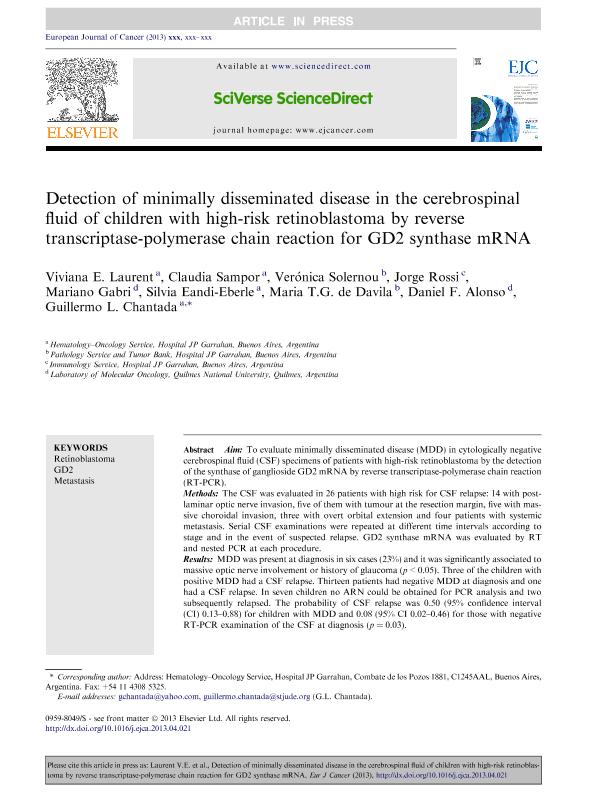Mostrar el registro sencillo del ítem
dc.contributor.author
Laurent, Viviana Eunice

dc.contributor.author
Sampor, Claudia

dc.contributor.author
Solernou, Verónica
dc.contributor.author
Rossi, Jorge
dc.contributor.author
Gabri, Mariano Rolando

dc.contributor.author
Eandi Eberle, Silvia
dc.contributor.author
García de Dávila, María T.
dc.contributor.author
Alonso, Daniel Fernando

dc.contributor.author
Chantada, Guillermo Luis

dc.date.available
2017-09-28T19:48:49Z
dc.date.issued
2013-09
dc.identifier.citation
Laurent, Viviana Eunice; Sampor, Claudia; Solernou, Verónica; Rossi, Jorge; Gabri, Mariano Rolando; et al.; Detection of minimally disseminated disease in the cerebrospinal fluid of children with high-risk retinoblastoma by reverse transcriptase-polymerase chain reaction for GD2 synthase mRNA; Elsevier; European Journal Of Cancer; 49; 13; 9-2013; 2892-2899
dc.identifier.issn
0959-8049
dc.identifier.uri
http://hdl.handle.net/11336/25354
dc.description.abstract
Aim: To evaluate minimally disseminated disease (MDD) in cytologically negative cerebrospinal fluid (CSF) specimens of patients with high-risk retinoblastoma by the detection of the synthase of ganglioside GD2 mRNA by reverse transcriptase-polymerase chain reaction (RT-PCR). Methods: The CSF was evaluated in 26 patients with high risk for CSF relapse: 14 with postlaminar optic nerve invasion, five of them with tumour at the resection margin, five with massive choroidal invasion, three with overt orbital extension and four patients with systemic metastasis. Serial CSF examinations were repeated at different time intervals according to stage and in the event of suspected relapse. GD2 synthase mRNA was evaluated by RT and nested PCR at each procedure. Results: MDD was present at diagnosis in six cases (23%) and it was significantly associated to massive optic nerve involvement or history of glaucoma (p < 0.05). Three of the children with positive MDD had a CSF relapse. Thirteen patients had negative MDD at diagnosis and one had a CSF relapse. In seven children no ARN could be obtained for PCR analysis and two subsequently relapsed. The probability of CSF relapse was 0.50 (95% confidence interval (CI) 0.13–0.88) for children with MDD and 0.08 (95% CI 0.02–0.46) for those with negative RT-PCR examination of the CSF at diagnosis (p = 0.03). Conclusions: MDD in the CSF detected by RT-PCR for GD2-synthase mRNA occurred in 31.7% of evaluable high-risk children with retinoblastoma with no initial central nervous system (CNS) involvement. It was significantly associated to optic nerve involvement and glaucoma and increased risk of CSF relapse.
dc.format
application/pdf
dc.language.iso
eng
dc.publisher
Elsevier

dc.rights
info:eu-repo/semantics/openAccess
dc.rights.uri
https://creativecommons.org/licenses/by-nc-sa/2.5/ar/
dc.subject
Minimally Disseminated Disease
dc.subject
Cerebrospinal Fluid
dc.subject
Retinoblastoma
dc.subject
Gd2 Synthase
dc.subject
Metastasis
dc.subject.classification
Reumatología

dc.subject.classification
Medicina Clínica

dc.subject.classification
CIENCIAS MÉDICAS Y DE LA SALUD

dc.title
Detection of minimally disseminated disease in the cerebrospinal fluid of children with high-risk retinoblastoma by reverse transcriptase-polymerase chain reaction for GD2 synthase mRNA
dc.type
info:eu-repo/semantics/article
dc.type
info:ar-repo/semantics/artículo
dc.type
info:eu-repo/semantics/publishedVersion
dc.date.updated
2017-09-28T18:13:19Z
dc.journal.volume
49
dc.journal.number
13
dc.journal.pagination
2892-2899
dc.journal.pais
Países Bajos

dc.journal.ciudad
Ámsterdam
dc.description.fil
Fil: Laurent, Viviana Eunice. Gobierno de la Ciudad de Buenos Aires. Hospital de Pediatría "Juan P. Garrahan". Servicio de Hemato-Oncología; Argentina. Consejo Nacional de Investigaciones Científicas y Técnicas; Argentina
dc.description.fil
Fil: Sampor, Claudia. Gobierno de la Ciudad de Buenos Aires. Hospital de Pediatría "Juan P. Garrahan". Servicio de Hemato-Oncología; Argentina
dc.description.fil
Fil: Solernou, Verónica. Gobierno de la Ciudad de Buenos Aires. Hospital de Pediatría "Juan P. Garrahan". Servicio de Patología; Argentina
dc.description.fil
Fil: Rossi, Jorge. Gobierno de la Ciudad de Buenos Aires. Hospital de Pediatría "Juan P. Garrahan"; Argentina
dc.description.fil
Fil: Gabri, Mariano Rolando. Universidad Nacional de Quilmes. Departamento de Ciencia y Tecnología. Laboratorio de Oncología Molecular; Argentina. Consejo Nacional de Investigaciones Científicas y Técnicas; Argentina
dc.description.fil
Fil: Eandi Eberle, Silvia. Gobierno de la Ciudad de Buenos Aires. Hospital de Pediatría "Juan P. Garrahan". Servicio de Hemato-Oncología; Argentina
dc.description.fil
Fil: García de Dávila, María T.. Gobierno de la Ciudad de Buenos Aires. Hospital de Pediatría "Juan P. Garrahan". Servicio de Hemato-Oncología; Argentina
dc.description.fil
Fil: Alonso, Daniel Fernando. Universidad Nacional de Quilmes. Departamento de Ciencia y Tecnología. Laboratorio de Oncología Molecular; Argentina. Consejo Nacional de Investigaciones Científicas y Técnicas; Argentina
dc.description.fil
Fil: Chantada, Guillermo Luis. Gobierno de la Ciudad de Buenos Aires. Hospital de Pediatría "Juan P. Garrahan". Servicio de Hemato-Oncología; Argentina. Consejo Nacional de Investigaciones Científicas y Técnicas; Argentina
dc.journal.title
European Journal Of Cancer

dc.relation.alternativeid
info:eu-repo/semantics/altIdentifier/url/http://www.sciencedirect.com/science/article/pii/S0959804913003559
dc.relation.alternativeid
info:eu-repo/semantics/altIdentifier/doi/http://dx.doi.org/ 10.1016/j.ejca.2013.04.021
Archivos asociados
